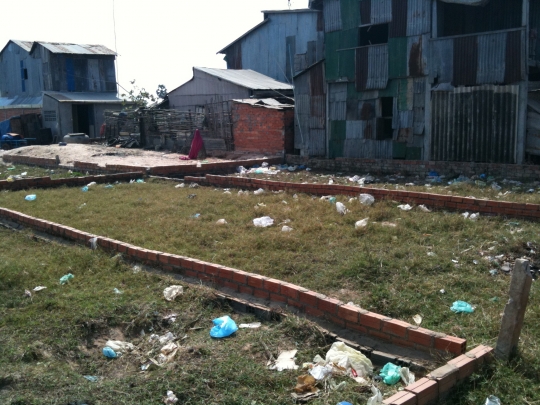This post continues the story of Seungho’s trip to Cambodia with Aalto University. Read the first part if you want to catch up...
So here we were, nine of us from five different countries seeing Cambodia for the first time. Seeing and living were very different from reading, watching and listening in comfortable homes and lecture halls. Things taken for granted at home were not easily achievable here: clean water, sanitation, sewage management, waste management and education, just to name a few.
We were lucky to have people with many different backgrounds: industrial and strategic design, architecture, urban planning and landscape architecture, which enabled each of us to focus on a few topics to develop deep insight so that we could help others see problems from various perspectives while working in teams. Nightly briefings kept everyone clued in and these discussions were very fertile. We were also lucky to have students from different parts of the world in the course, as well as working with Cambodian students during our stay, which made the whole visit fluent and fruitful. Soon we’ll return to Helsinki and form groups with those who did not travel, expanding the diverse set of perspectives even more.
We are free to choose a site for our studio projects. Among the most terrible of the relocation sites was Trapieng Krasang, where the urban poor from four different places were involuntarily relocated to some 20kms outside the city and they now struggle to survive. This is a population of Tuk-Tuk drivers, Moto-Dub drivers, bakers, street fruit vendors, waiters and waitresses who have been relocated away from their jobs and now have no income. One lady, for example, makes two and a half dollars a day if she goes to the city to sell vegetables. However, it costs two dollars to get to the city! The relocated families were each given nothing but a 5 by 12 meter plot on a former rice field. The earth is fertile there, but the plot is far too small to be the source of living, let alone the money to build a shelter.

Empty plots in Trapieng Krasang. Many of the evicted families sold the plots for very cheap price and headed back to the city slums due to the lack of job opportunity. Sold plots have become the subject of speculation, which will make the rich richer.
This is compounded by the issue of unclear entitlements, which dates back to the Khmer Rouge regime when many citizens were herded out of the city. One third were killed and many of the survivors never returned. Eventually, those who did return to the city settled wherever they could – with whatever means they could. A few decades later, the Cambodian government, challenged with deep-rooted corruption, is selling the prime locations of Phnom Penh city to private investors who are taking advantage of murky land ownership status.
Development in the city of Phnom Penh is another significant problem. Two years back, a private investor bought the Boeung Kak Lake area which is about 1 square kilometer and began filling in the lake to build a hotel and resort. People near the lake have been forcibly relocated and a large fire during our stay in Phnom Penh cost hundreds of families their homes in a single night. Now Boeung Kak Lake is as small as one third and soon will be 10 per cent of its original size. As summer brings monsoon season we will see the impact of the such radical environmental changes. Recently the Royal University of Fine Art as well as the National Museum have been sold to a private investor and the students are under threat of eviction.
![Boeung Kak lake as of March 2010.
Photo credit: Save Boeung Kak Campaign [http://saveboeungkak.wordpress.com]](../peoplepods/files/images/383.540.jpg)
Boeung Kak lake as of March 2010.
Photo credit: Save Boeung Kak Campaign [http://saveboeungkak.wordpress.com]
Some can say that development in Phnom Penh is giving jobs to construction workers, hopefully boosting the economy, and making the city a better place to live in the end. However, the number of the people evicted from the city is much higher than the number of workers hired. Does development have to be at the expense of so many homes, jobs, and lives lost?
The economy of urban poor in Phnom Penh is shallow and fragile: many of their livelihoods are very much dependent on tourism, a competitive industry with significant competition from nearby Bangkok. Cambodia imports many things, including foodstuffs, from Thailand and Vietnam, thus making commodities expensive. The shift from agrarian to industrial society, then an industrial, and on to a service and knowledge-based economy appears to be a long journey for Cambodia.
City in Crisis course does not pretend that problems of this nature can be mitigated immediately. Rather, it aims to have us students aware of and ready for the real problems of architecture and design for a longer term.
Back in Helsinki, we’re focusing on five different projects: a master plan including urban farming solutions for the relocation sites, in particular Trapieng Krasang as a case study; a “sub-center” concept for relocation sites, which brings markets and basic facilities to the area; the rehabilitation of remaining lake areas south of Phnom Penh, with specific attention to management of sewage flow; disaster management for slum inhabitants; and finally mine, a strategic road map and a framework for the economical development of the urban poor of Cambodia.
My question started from the living condition of Trapieng Krasang but my interest has soon extended to the economy of urban poor and the mindset: what does a pathway to economic stability look like for the relocated families of Trapieng Krasang?


